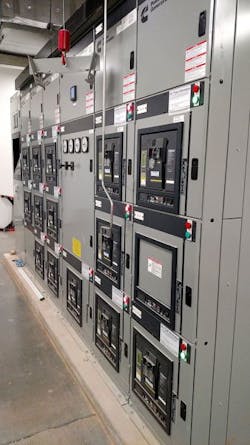What came first — the chicken or the egg? This age-old question has been perplexing society for generations. The electrical equivalent of this timeless dilemma is “What came first — the distribution equipment or the coordination study?” In the last few months, I have had many “discussions” with construction team members regarding this topic — most of them not too pleasant.
Before we jump into a discussion and potential resolution of this situation, let’s just refresh with a simple definition of selective coordination. In a nutshell, a selectively coordinated system means that each overcurrent protective device (OCPD) in an electrical distribution system does its job in the correct order. If there is a fault (or an electrical incident) at a receptacle, the goal is that the OCPD in the panel serving that device (i.e., 20A breaker) trips before the main OCPD of the panel, which trips before the OCPD providing power to the panel before the OCPD of that panel trips before, and so on.
Now, here’s a quick history lesson. Selective coordination has been required for emergency systems in health care facilities since 1985, and had been required for elevators for many years before that. The 2014 iteration of NFPA 70, The National Electrical Code (NEC), Sec. 700.28 states: “Emergency system(s) overcurrent devices shall be selectively coordinated with all supply-side overcurrent protective devices.” This same sentiment is also reiterated in Sec. 701.27 for Legally Required Standby Systems and in Sec. 708.54 for Critical Operations Power systems. Section 517.30(G) further enhances the requirement for selective coordination of a health care facility by requiring the essential electrical system to be coordinated for the “… period of time that a fault’s duration extends beyond 0.1 seconds.” This requirement aligns with the current iteration of NFPA 99, Health Care Facilities Code, and finally quantifies a time duration for which the system is to be coordinated. (Note that earlier versions of NFPA 70 and NFPA 99 do not align, and, depending on the edition, may be silent regarding the level of coordination required).
It is always prudent to talk to the local AHJ regarding applicable code versions and selective coordination requirements. Some AHJs (and some states or jurisdictions) still require selective coordination to 0.01 second because the old fashion “onion skins” were drawn down to 0.01 second. (Note that selective coordination is only required by Code on the emergency system side of distribution). It is also important for the bidding contractor to read the engineer’s specification because he or she may have more stringent requirements to also coordinate the extent of the normal distribution.
As I always say: Code minimum is code minimum — and not necessarily best practice nor standard of care. But now back to the real topic — which came first? The discussion always starts: How can I submit equipment for you to review if I don’t know if it coordinates? The reply is typically: How do you know it coordinates if you don’t submit equipment for the coordination study? It seems like a never-ending loop, doesn’t it? The second question typically is: If you don’t know what equipment will coordinate, what did you design, and what did you specify?
Reality is that engineers actually do have a general sense of what equipment will coordinate; we use the old “fuse thumb rule of 2 to 1,” but the final coordination of each specific piece of equipment is based upon a myriad of factors.
One of the primary differentiators is the manufacturer. Each manufacturer has different coordination curves for each fuse size and type, breaker type, frame size, and trip rating of their own equipment. A 400A breaker for one manufacturer could coordinate with a 600A breaker, but for an alternate manufacturer the frame size for the breaker may need to increase to an 800A frame to permit the system to selectively coordinate. Making this modification could change the type of panel the breaker is installed in, the physical size of the panel, and subsequent breakers upstream and downstream. Available fault current also can impact how overcurrent devices coordinate with each other. Most manufacturers have tables where they have tested breakers in series (not series rated breakers — that’s a different topic) for defined levels of available fault current. This could allow breakers that do not coordinate “on the curves” (aka onion skins) to coordinate at a defined fault current level. Feeder length also makes a difference, as do any pieces of equipment in line between two OCPDs. A longer feeder or a transformer will drop your available fault current and may allow additional devices to be coordinated solely based upon the tested tables for the available fault current.
The NEC requires a selective coordination study to be implemented by a licensed engineer. The design engineer typically runs a preliminary study with one manufacturer’s equipment and estimated feeder lengths. This study is what the engineering design is based upon, and modifications of the distribution system are made where applicable. Once the project is bid and awarded, the onus of running the study with the anticipated equipment and feeder lengths shifts to the electrical contractor. Typically, the contractor engages the chosen manufacturer to run the study using their equipment to confirm breaker size, settings, available fault current, and arc flash levels. Most manufacturers have an engineering department with licensed engineers whose primary responsibility is to create these studies. Once the study is completed, it is submitted to the engineer for review to assure all of the design parameters and code compliance requirements are met. The study also recommends modifications to the submitted equipment if frame sizes or fault current values are required to be changed to achieve coordination. There are typically at least two rounds of submittal reviews prior to approval of the study and subsequently the electrical distribution equipment. Be mindful that actual available fault current from the electric utility and specific generator information are also required to create a valid study.
So what’s the answer to the question, “What came first — the distribution equipment or the coordination study?” That’s simple — they both walked across the street together.




